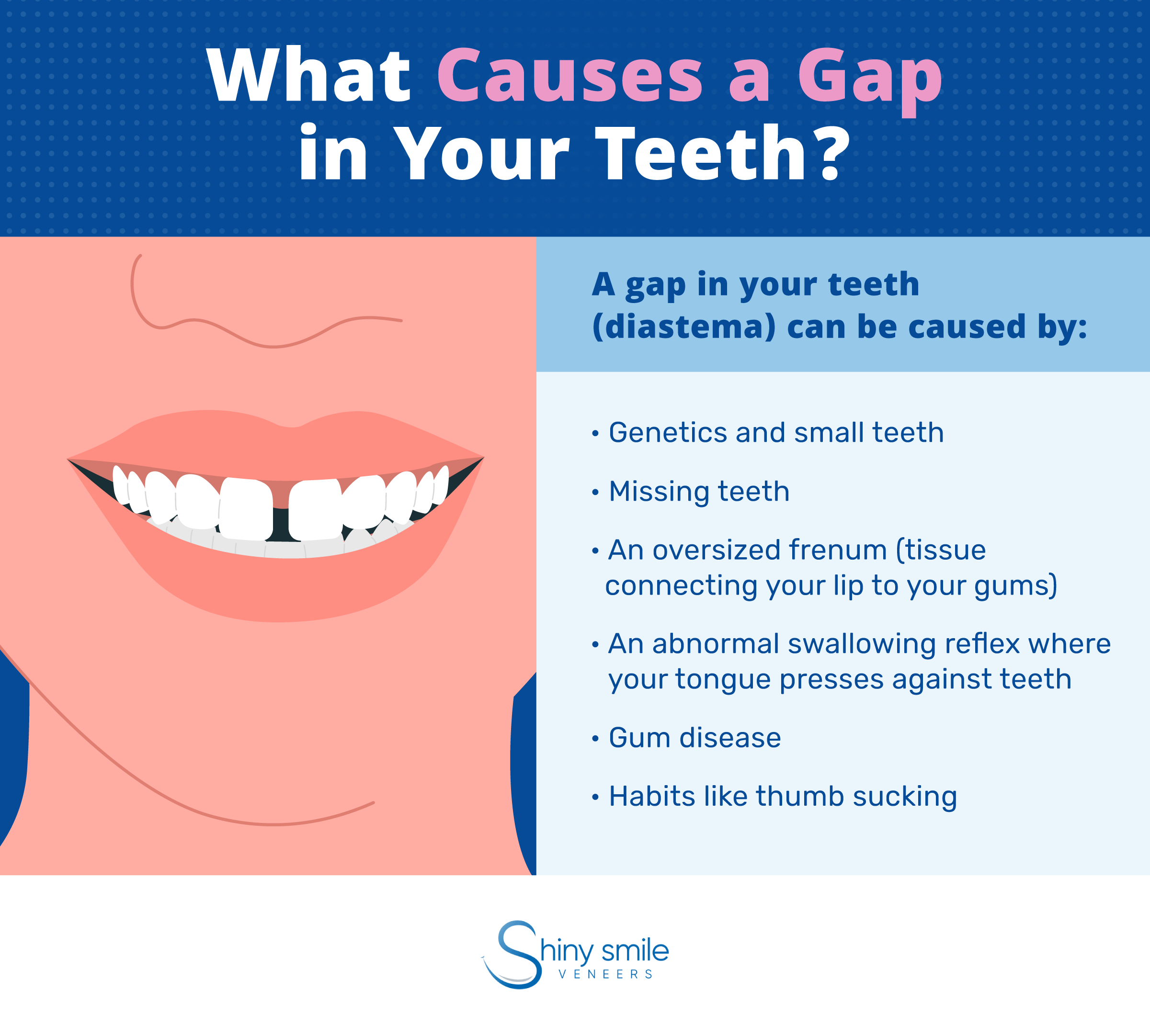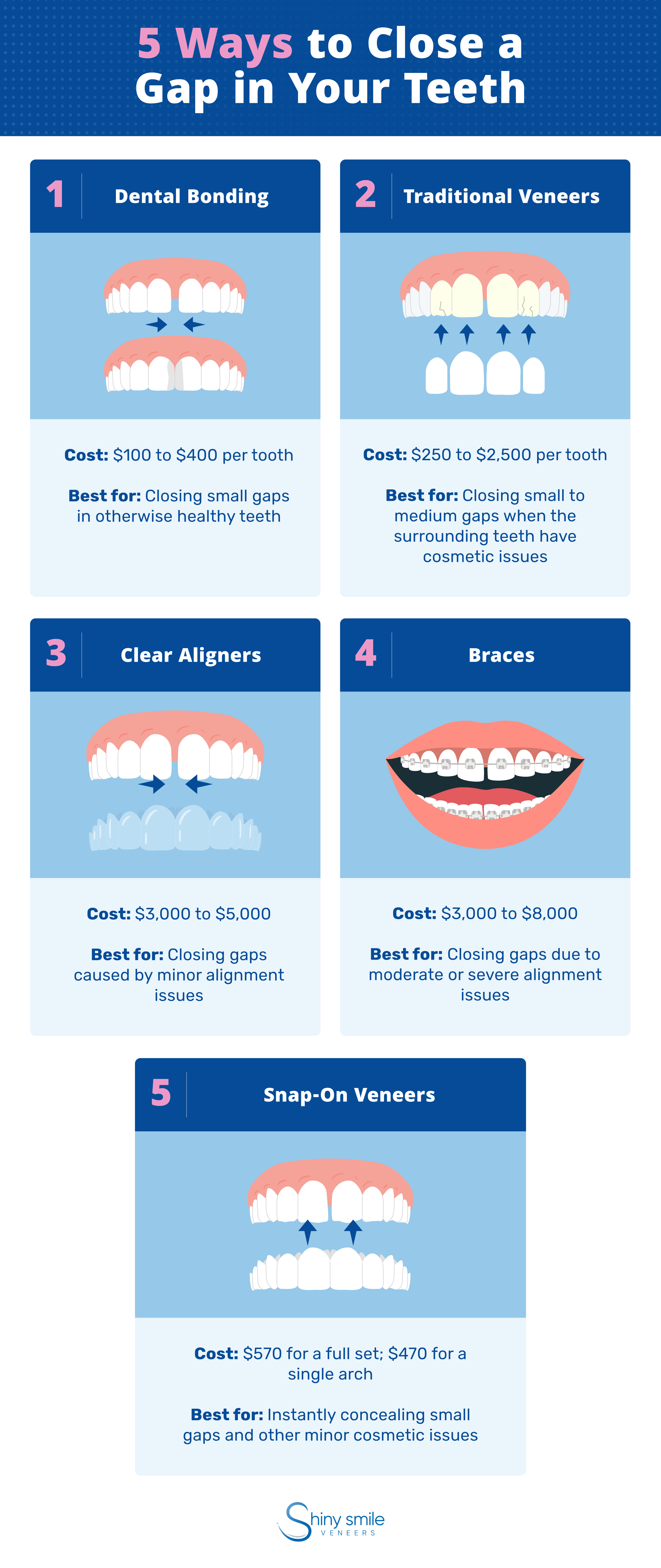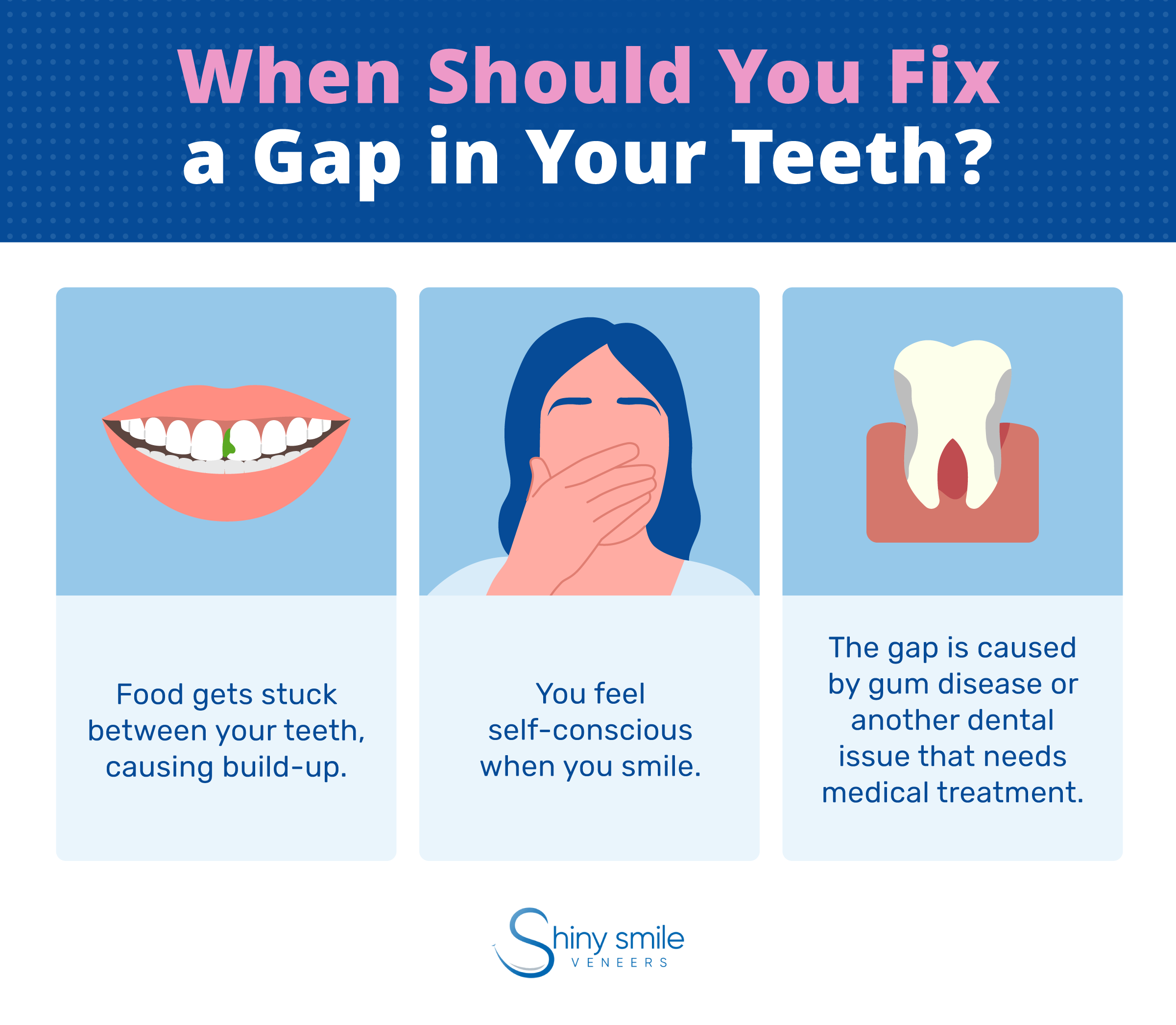

All kinds of issues can cause gaps in your teeth, but often it’s simply genetics that give you the unwanted spacing. If you’re having issues talking or eating because of the gap or simply feel a dip in self-confidence, then you might want to look at getting your gap closed or concealed.
In this post, we explain how to close a gap in your teeth five different ways, which scenarios each solution is best for, and the cost and type of procedure involved.
Table of Contents
- What Causes Gaps in Teeth?
- 5 Solutions to Fix a Gap in Your Teeth
- Should You Fix a Gap in Your Teeth?
- How Much Does it Cost to Close a Tooth Gap?
- Can You Reduce a Gap Naturally at Home?
- Get a Beautiful Smile Instantly with Snap-On Veneers

What Causes Gaps in Teeth?
Gaps in your teeth are often caused by:
- Genetics: If you’re born with small teeth, you may be more prone to gaps. This is because smaller teeth on a larger jawbone have more room to move and create spacing.
- Missing teeth: If you lose a tooth, chances are it will cause a gap to develop between other teeth. This is because the extra space in your mouth will cause your teeth to shift and move apart.
- An oversized labial frenum: Frenum is the tissue that connects your lips to your gums. If the frenum that connects your upper lips to your gums becomes too large, it can create gaps in your teeth.
- Abnormal swallowing reflex: Sometimes, simple reflexes can cause gaps. If your tongue presses against your front teeth instead of the roof of the mouth when you swallow, the pressure can cause a gap.
- Gum disease: Bad oral hygiene can lead to inflammation, which loosens teeth and causes gaps to appear. Advanced gum disease can also cause your jawbone to erode, which will give your teeth even more of a gap.
- Bad habits: Habits like thumb sucking or tongue thrusting can put pressure on the front teeth, and push them both forward and apart.
If the gap between your teeth becomes wider than 0.5 millimeters, then dentists call that “diastema.” It’s possible to get a gap between any of your teeth, but the most common causes occur between the two upper front teeth.
Some of these causes will require treatment from a dentist before you can begin to work on closing the gap. If your gap is caused by gum disease, you will need a periodontal treatment before you close on the space in your teeth. If an oversized frenum is an issue, then your dentist may want you to get a frenectomy. This surgery will cut the band of tissue and release it so that it no longer causes spacing.
5 Solutions to Fix a Gap in Your Teeth
If you have good oral health, then there are several treatment options for you, which we discuss below. If your gap is caused by a missing tooth, take a look at our tooth replacement options to close the gap.

1. Dental Bonding
If you only have a small gap in your teeth that’s making you self-conscious, then you can most likely get rid of your gap using dental bonding. A dentist will apply a tooth-colored paste to your teeth and use a light to harden it. If the gap is small enough, your dentist can apply the resin within the gap to make it completely disappear.
This is one of the most affordable ways to fix a gap in your teeth, as it can cost between $100 to $400 per tooth. You might even get your insurance to cover this procedure, depending on the type of coverage you have. Dental bonding is also a quick procedure, with it taking about 30 to 60 minutes for a tooth. The results should last from 3 to 10 years.
Best for: Closing small gaps in otherwise healthy teeth
2. Traditional Veneers
If your gap is small, but not small enough for dental bonding, then traditional veneers are the option for you. Dental veneers are thin shells that are bonded to the front of your teeth. Not only do they cover up gaps, but they can also cover up discoloration or chipping. To get veneers, you have to have some of your tooth enamel removed, which makes this process permanent.
There are two types of traditional veneers: porcelain and composite resin. Porcelain veneers look the most like natural teeth but require a lot of tooth enamel to be removed. They will last up to 10 years and cost about $925 to $2,500 per tooth. Composite resin veneers are less durable but are cheaper and quicker to get. They last up to five years and cost around $250 to $1500 per tooth. Because veneers, whether porcelain or composite resin, are a cosmetic procedure, your insurance most likely won’t cover it.
Best for: Closing small to medium gaps and closing gaps when the surrounding teeth have some cosmetic issues
3. Clear Aligners
If you have a sizeable gap in your teeth but don’t want braces, then you could get clear aligners like the ones sold by Invisalign. Clear aligners are clear, plastic trays that fit over your teeth, forcing them together and closing the gaps. You’ll begin wearing one set for two weeks, then switch to a smaller set for another two weeks. You’ll repeat this process until the gap is closed.
You will have to wear your aligners for at least 20 hours a day, but treatment will only take less than a year. In the US, your clear aligners will cost about $3,000 to $5,000 but could be covered by some insurance policies.
Best for: Closing gaps caused by minor alignment issues
4. Braces
With a large gap, you might need braces that apply force to your teeth to eliminate the spacing. There are several types, including alternatives to traditional metal braces:
- Traditional: These braces use metal wires to realign your teeth, held in place with metal brackets. While one of the more noticeable options, traditional braces can apply the pressure needed to close the gaps in your teeth.
- Ceramic: These are like the traditional braces but less noticeable as the tooth-colored brackets blend in with your teeth.
- Lingual: Lingual braces look and work just like traditional braces but are placed on the back (or lingual) side of your teeth. This makes them barely noticeable to others.
- Self-ligating: Instead of brackets, these braces hold the archwire in place with clips, making them more comfortable in your mouth.
Braces will require regular check-ups at the orthodontist and need to be worn for one to three years. They can cost between $3,000 to $8,000, depending on the issue you’re facing. Braces might be covered by your insurance, but only if it covers orthodontic treatment.
Best for: Closing gaps due to moderate or severe alignment issues
5. Snap-On Veneers
Like traditional veneers, snap-on veneers conceal gaps in teeth and other cosmetic woes. Instead of being an irreversible process, snap-on veneers clip over your teeth and give you that confident smile back instantly!
You can order your veneers online, using an impressions kit at home to be sure you receive the right veneers for your unique set of teeth. This eliminates the need to go back and forth from the dentist. With regular use, you can expect your veneers to last one to five years.
Shiny Smile veneers cost $570 for a full set and $370 for a single arch. You can pay upfront or space it out by using one of the payment plans available. Snap-on veneers may not be covered by your insurance, but are an affordable, non-permanent process.
Best for: Concealing small gaps and other minor cosmetic issues instantly
Should You Fix a Gap in Your Teeth?
If the gap is getting in the way of you completing everyday tasks, such as eating, then you may want to consider fixing your gap. If your self-confidence is a bit lower due to the gaps in your teeth, then go ahead and fix your gap to look better cosmetically.
If your gap issues stem from gum disease like periodontitis, then you will have to have this issue fixed regardless, even if you don’t close the gap in your teeth. With periodontitis, various treatment options are available. You can treat mild issues with antibiotics or root planing (a cleaning treatment that involves anesthesia to decrease pain), while you may have to treat more severe issues with surgery.

How Much Does it Cost to Close a Tooth Gap?
The cosmetic treatments discussed, such as bonding and traditional veneers, will cost between $100 to $2,500 per tooth. Orthodontic treatments can cost $3,000 to $8,000 and have a better chance of being covered by your insurance compared to cosmetic solutions. If you want a less-invasive alternative, try snap-on veneers. Snap-on veneers like the ones made by Shiny Smile Veneers are affordable, costing $370 for a single arch and $570 for a full set.
Can You Reduce a Gap Naturally at Home?
Your teeth are essential to your day-to-day life, so don’t run the risk of damaging them by trying any DIY remedy to close gaps. You should always go to the dentist to fix gaps. If you don’t want to alter your teeth by having the enamel removed or forcing them back together via clear aligners or traditional braces, then you can simply conceal the gap.
Shiny Smile Veneers can be customized to your teeth and ordered from your home without having to see a dentist. First, you’ll order an impressions kit to your house. This allows you to make casts of your teeth so that the veneers fit over your existing teeth properly. Once you send the kit back, the veneers can be customized to your mouth and sent back to you. After getting your veneers, you can clip them over your teeth and see an instant change in your smile!
Get a Beautiful Smile Instantly with Snap-On Veneers
If you’re suffering from a gap in your teeth, don’t worry! There are plenty of options for you to close the gap and increase your confidence with a brand new smile. Use Shiny Smile Veneers to gain that self-confidence back instantly!
